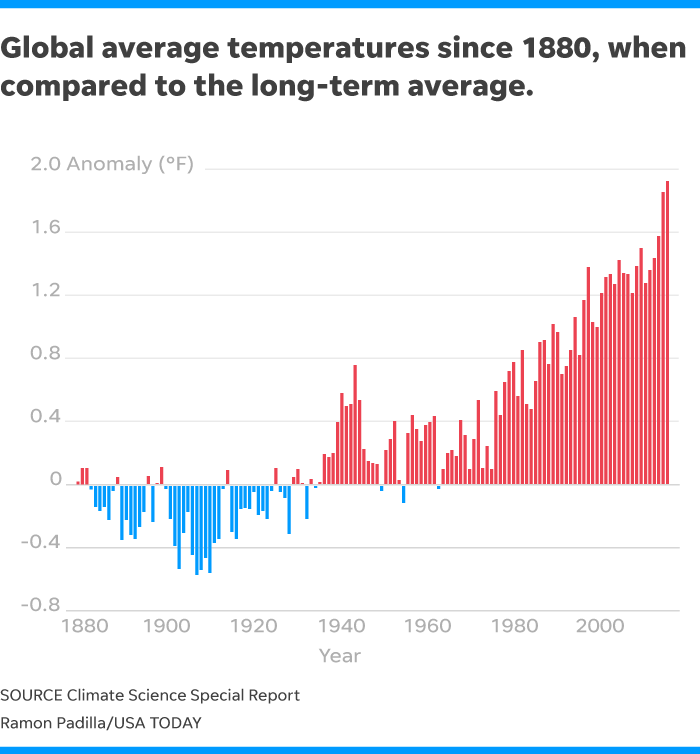Humans to blame for global warming, massive federal government report says
 Doyle Rice
Doyle Rice
Climate change is real, it's here and we're the cause of it, according to the USA's most comprehensive climate science report ever produced.
With the planet the warmest it's been in the history of modern civilization, the federal government said Friday that "it's extremely likely that human activities, especially emissions of greenhouse gases, are the dominant cause of the observed warming since the mid-20th century."
The contents of the report contradict claims by President Trump and his administration that continually downplay human contribution to climate change and question the ability of scientists to predict its effects.
"For the warming over the last century, there is no convincing alternative explanation supported by the extent of the observational evidence,” the report concluded.
The document serves as Vol. 1 of the National Climate Assessment, a federally mandated report prepared by the nation's top scientists every four years for the president, the Congress and the public. This assessment is the fourth such report.
No policy recommendations are included in the report, only scientific information, according to coordinating lead author David Fahey of the National Oceanic and Atmospheric Administration. There was also no interference from policymakers, he added.
In addition, the White House Office of Science and Technology signed off on the report, said Virginia Burkett, a scientist with the U.S. Geological Survey and acting chair of the subcommittee on Global Change Research.
"The assessment is like a doctor’s report that evaluates a patient’s vital signs and uses that information to diagnose a medical condition," said Rachel Licker, senior climate scientist at the Union of Concerned Scientists. "In this case the medical condition is climate change and the symptoms are rising temperatures, higher sea levels and more extreme weather events."
More:How climate change can hit your small business
More:Climate change is causing a nightmare — lost sleep
Hundreds of scientists from 13 federal agencies assessed more than 1,500 scientific studies and reports to produce the paper. The National Academy of Sciences also peer-reviewed it before release.
Other findings include:
- Global average sea level has risen by about 7-8 inches since 1900, with almost half (about 3 inches) of that rise occurring since 1993.
- Global average sea levels are expected to continue to rise — by at least several inches in the next 15 years and by 1-4 feet by 2100. A rise of as much as 8 feet by 2100 cannot be ruled out.
- Heavy rainfall is increasing in intensity and frequency globally and across the United States and is expected to continue to increase.
- The rate of daily tidal flooding is accelerating in more than 25 Atlantic and Gulf Coast cities.
- Heat waves have become more frequent in the United States since the 1960s, while extreme cold temperatures and cold waves are less frequent.
- The rate of large forest fires in the western United States and Alaska has increased since the early 1980s and is projected to further increase.
- Annual trends toward earlier spring melt and reduced snowpack are already affecting water resources in the western United States.

Global atmospheric carbon dioxide concentration has now passed 400 parts per million, a level that last occurred about 3 million years ago, when both global average temperature and sea level were significantly higher than today.
The only solution to the problem is to reduce the amount of greenhouse gases, especially carbon dioxide, emitted globally, the report said.
More:Climate change juiced Hurricane Harvey
More:Climate change is making us sick, top U.S. doctors say
More:Who will pay most for climate change? South will be biggest loser
For the first time, the assessment also included a list of climate-related “surprises,” or unanticipated changes, in which tipping points in the Earth’s systems are crossed or climate-related extreme events happen at the same time, creating “compound extreme events,” multiplying the potential damage and destruction. They include large-scale shifts in major worldwide climate patterns that would wreak havoc on the global climate system.
"Climate models are more likely to underestimate than to overestimate the amount of long-term future change,” the paper concludes.
The second part of the assessment — which focuses on the impacts of climate change on human systems and ecosystems — was also released as a draft for public comment Friday.
Earlier this year, Trump said he planned to withdraw the U.S. from the landmark Paris climate agreement, which requires countries to establish ambitious targets to reduce the greenhouse gasses that cause global warming.
“The National Climate Assessment is only further proof that the Trump Administration can no longer attempt to misrepresent climate science of the country’s highest caliber as ‘fake news,' said Ken Berlin, president the Climate Reality Project. "The American people deserve to know the truth about the reality staring us square in the face.”
Former Vice President Al Gore chimed in on Twitter, noting that "if the Administration won't listen and if the federal govt. won’t act, states, cities, businesses, investors, and citizens will."
